|
Visiting
Mendoza, Argentina
Part 1: a question of altitude
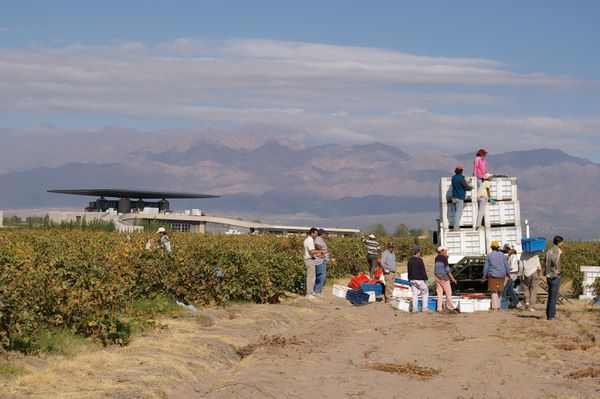
Harvesting
at O Fournier, Uco Valley, Mendoza - altitude 1200 m - Andes in the
background
One of the perks of being a
wine writer is the chance to travel widely, often at other people’s
expense, to beautiful parts of the world where you get to eat and
drink very well. As I’m reasonably new to this job, I’m still in
the process of ticking off the world’s leading wine regions on my
list of ‘places that I must visit’. In November 2007, I visited
New Zealand for the first time, then in January 2008 I was in Chile.
Then, in March 2008 I made my first trip to Argentina. It’s hard
work, all that long-haul travelling, but someone has to do it.
I was really looking forward
to visiting Mendoza, Argentina’s largest and most important wine
region, because I'd read so much about it. In particular, with my
science geek hat on I was intrigued by the effect of altitude.
Increased altitude means decreased temperature and increased solar
radiation. In most of the world’s wine regions, grape growing
stops at around 1000 metres: past this, it just gets too cold to
ripen grapes properly. In Mendoza, the average altitude of the
vineyards is a heady 900 metres, with many well above 1000 metres
(in fact, the highest vineyards in the world are found in Argentina,
in Salta, at just over 3000 metres). It’s this topic – the
effect of altitude on Mendoza’s vineyards, that will be the
subject of this first report from my visit. Then I’ll write-up the
individual producer visits in detail.
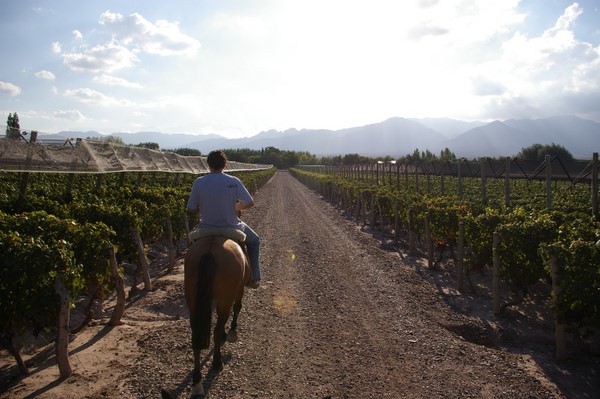
Riding
through the vineyards at Cheval des Andes - the netting is for hail
protection
Expectations can mislead. I’d
expected Mendoza to have these amazing, sloping high-altitude
vineyards in the foothills of the Andes. The reality? All the
vineyards look pretty much the same. And they’re all flat. A
vineyard at 800 metres looks pretty much the same as one at 1400
metres, because the gain in altitude is a very gradual one on the
plateau that leads to the Andes. But this doesn’t change the fact
that altitude is hugely important in making quality wine production
viable in Argentina. With the exception of Patagonia in the south,
Argentina’s wine regions form a strip running down the spine of
the Andes in the west of the country and, remarkably, have an
average altitude of 900 metres, which makes Argentina unique as a
wine-growing country. Of course, elsewhere in the world grapes are
grown at altitude – the mountain wines of the European Alps spring
to mind, as does Ribera del Duero which is at an altitude of around
800 metres, but Argentina takes this to another level.
It’s worth making a
comparison with Chile’s vineyards, which are just a short hop over
the Andes. In Chile, site selection is all about understanding the
effect of the cooling breezes from the chilly Pacific Ocean, as they
work their way inland through gaps in the coastal ranges and up
river valleys. Because Chile is such a long, narrow country, all the
wine regions are affected to some degree by the proximity of the
Pacific, and specifically the chilly Humboldt current. Mendoza is
quite different. It’s more than a thousand kilometers from the
Argentinean coast, lying to the east; to the west are the Andes,
which create a rain shadow, but provide a plentiful supply of
irrigation water. In most of the Argentinean wine regions, site
selection is determined by the altitude of the vineyards because
there is no maritime influence.
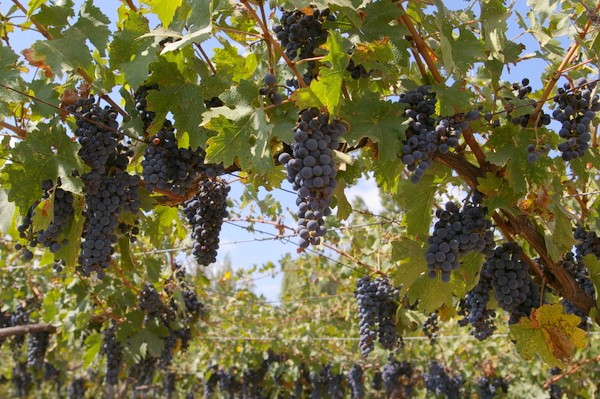
Old
fashioned pergola-style trellising
But what is the influence of altitude?
The most obvious change is in temperature. ‘Without a doubt, the
fundamental benefit of high altitude vineyards is the temperature,
which gets lower the higher the altitude’, says Dr Rodolfo Griguol,
Chief Winemaker for La Riojana. ‘But this is not all: it is also
important to consider the high difference between the day and night
time temperatures’.
So
altitude brings with it two influences on temperature. First of all,
it gets cooler, by an average of about 0.6 ºC per 100 metres, and
during the important ripening months it’s as much as a 1 ºC
difference. And then there is an increased day/night temperature
amplitude. Manuel Louzada of Terrazas de los Andes explains the
significance of this. ‘During the day the plant produces, via
photosynthesis, carbohydrates that are taken into the reserve
organs, such as the berries. Throughout the night, respiration takes
place without photosynthesis, consuming some of the carbohydrates
and other organic compounds. The lower the night temperature and,
therefore the bigger the thermal amplitude, the lower the amount of
these components consumed during respiration, resulting in more
intensity of the grape expression due to a bigger richness in the
berry of these components, that affect colour, aroma and palate
structure.’ Louzada and
his team at Terrazas have made altitude differences a feature of the
labelling of their wines, with the term ‘The ideal altitude for
each varietal’ displayed prominently.
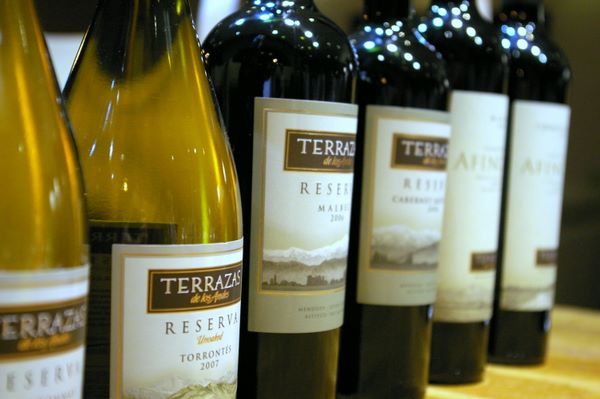
‘Altitude is terribly
important for us mainly in order to achieve not only extreme
high-low temperatures in the summer, but also that low temperatures
should be below 14 ºC,’ says José Ortega, president of O
Fournier. ‘The extreme temperatures increase
colour and aroma intensity. The low temperature situation allows for
added natural acidity and freshness in the aromas. For us, higher is
definitely better in Mendoza and that is why we invested in the Uco
Valley at 1200 m altitude.’
But it is not just
temperature that varies with altitude. There are two other important
factors: sunlight intensity, and soil characteristics. ‘The origin
of the Mendoza region soils are alluvial. Therefore, as we
"climb up" the mountain we will find soils, with similar
"mother rock", that have a bigger granulometry’, says
Louzada. ‘Soils with bigger granulometry usually have better
drainage, retaining less humidity and have
smaller availability of nutrients (mainly organic matter) that makes
them less fertile soils where the plant naturally has to struggle to
survive. This type of soils allows a better control of the
irrigation practices.’
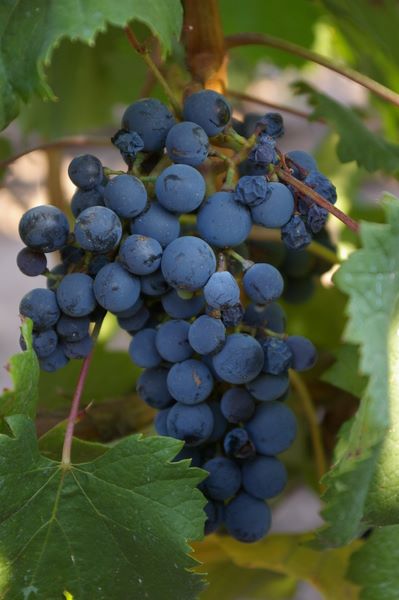 With increased altitude, the
intensity of the sunlight increases. The role of this increased
light intensity is currently being investigated by Catena’s
research and development department headed up by Laura Catena and
Alejandro Vigil. ‘We are constantly conducting investigations,
mostly in high altitude viticulture, on the effect of altitude, high
sunlight intensity, temperature and its effect in the
characteristics and quality of Malbec’, explains Catena winemaker
Mariela Molinari. The Catena vineyards range from 780 m (quite high
by conventional standards) in Este Mendocino to 1500 m (Valle de Uco)
above sea level. These different altitude vineyards can be matched
to different varieties, but what Catena have done in their research
project is to examine how one variety, Malbec (right),
performs with varying elevation. ‘We have seen that sunlight
intensity in the high altitude vineyards has a great effect on the
aromatic profile of Malbec. The aromatic precursors of Malbec that
belong to the carotenoid family are enhanced with the sunlight
intensity.’ In addition, the higher ultraviolet light levels at
increased altitude have an important effect on tannin composition.
‘The grape skins in the Malbec from high altitude are thicker,
which translates into higher concentration of total tannins’, says
Molinari. ‘This is very important since this is an indicator of
quality in relation to concentration. But most important is the type
of tannins that we find in these grape skins, fewer monomeric
tannins and proportionally higher concentration of polymeric
tannins. This means that in our high altitude Malbecs we have high
concentration and structure, with an incredible amount of total
tannins but yet very soft and round wines. This is what makes
Malbecs from high altitude vineyards so unique’. With increased altitude, the
intensity of the sunlight increases. The role of this increased
light intensity is currently being investigated by Catena’s
research and development department headed up by Laura Catena and
Alejandro Vigil. ‘We are constantly conducting investigations,
mostly in high altitude viticulture, on the effect of altitude, high
sunlight intensity, temperature and its effect in the
characteristics and quality of Malbec’, explains Catena winemaker
Mariela Molinari. The Catena vineyards range from 780 m (quite high
by conventional standards) in Este Mendocino to 1500 m (Valle de Uco)
above sea level. These different altitude vineyards can be matched
to different varieties, but what Catena have done in their research
project is to examine how one variety, Malbec (right),
performs with varying elevation. ‘We have seen that sunlight
intensity in the high altitude vineyards has a great effect on the
aromatic profile of Malbec. The aromatic precursors of Malbec that
belong to the carotenoid family are enhanced with the sunlight
intensity.’ In addition, the higher ultraviolet light levels at
increased altitude have an important effect on tannin composition.
‘The grape skins in the Malbec from high altitude are thicker,
which translates into higher concentration of total tannins’, says
Molinari. ‘This is very important since this is an indicator of
quality in relation to concentration. But most important is the type
of tannins that we find in these grape skins, fewer monomeric
tannins and proportionally higher concentration of polymeric
tannins. This means that in our high altitude Malbecs we have high
concentration and structure, with an incredible amount of total
tannins but yet very soft and round wines. This is what makes
Malbecs from high altitude vineyards so unique’.

Catena's
Adrianna Vineyard, Mendoza - 1400 m
'The same grape variety has
totally different behaviours at different altitudes’, agrees
Manuel Louzada, who explains the differences that Terrazas find with
different Malbecs. ‘Let’s take the example of Malbec. (1) Malbec
from warmer regions (below 900 meters) tends to accelerate its sugar
ripeness yet with limited fruit expression or developing over
ripeness characters, with leathery and/or cooked aromas and flavours
with flat structure on the palate; (2) Malbec from the Vistalba
region (between 1000–1100 m), has the perfect balance between
sugar ripeness and the accumulation of the components that deliver
character, expression and concentration. The Malbec wines from
Vistalba, display the typical aromas of Malbec like plums, raisins,
raspberry, black pepper and violets with a full body, creamy texture
yet with sweet and round tannins. We could define this as more
elegant and complex Malbec. (3) Malbec from the Uco Valley (between
1000–1100 m yet at the south limit of Mendoza, latitude 33 °S)
achieves an incredible concentration yet with aromas that are mainly
flowery, specially violets, and fresh fruit like raspberry. In the
palate the wines tend to have sweet fruit in the front palate, a
lighter middle palate and tannins that are firmer and harder in the
back palate. More muscular Malbec.’ Louzada adds that if they
tried planting Malbec at higher elevation the ripening cycle would
be so long that it wouldn’t complete, and the resulting wines
would be green and vegetal. ‘I think it is a matter of the style
you are trying to achieve, for example for certain wines, it may
interesting to blend the wines obtained with grapes from the
vineyards planted at 2 and 3, to increase the level of intensity and
some complexity on the grape expression. Nevertheless, if your are
pursuing a unique expression of the terroir, as we are in the case
of our Afincado, it comes from a small plot within our own vineyard
"Las Compuertas" planted in 1929 where we think we have
found, by itself, the perfect expression of Malbec.’
Wines tasted 03/08
Find these wines with wine-searcher.com
Back
to top
|

